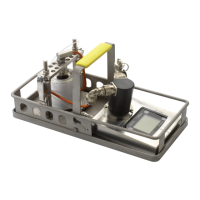HAFFMANS RPU 352, RPU 353, RPC 80 RPC 50
2
RPU 352, RPU 353, RPC 80, RPC 50 Page 43 of 112
15
MAINTENANCE
General
To maintain the accuracy and reliability of the equipment we recommend that it is
serviced and re-calibrated (with the probes) at regular intervals. Under light
conditions of use this should be carried out at least every 1500 recording runs.
When the equipment is heavily used, particularly where high pasteuriser
temperatures are involved as with fruit juices, then the service and re-calibration
should take place every year.
If this work is done by the manufacturers or an approved agent then the
calibration and service details can be recorded in the equipment and are
available via the status report.
The regular service will replace both temperature probe sockets and the battery
(see below) and so ensure reliable operation.
Dessicant
The dessicant in the electronics housing needs to be replaced annually.
Probe sockets
The probe sockets should be lubricated after every 50 recording runs using the
contact treatment grease supplied. This protects the sockets from corrosion and
greatly extends their service life. A lubrication reminder is shown on the display
at the correct times.
If you leave a probe or dummy plug permanently connected to one of the
channels it is important to unplug it occasionally and lubricate the socket before
replacing it. The lubrication reminder applies to all sockets.
If the equipment has not been returned for servicing as recommended above
then after about a year of heavy use (or two years of light use) then the exchange
unit should be replaced as a precaution. The exchange unit includes both
temperature probe sockets and the battery. Full fitting instructions are enclosed
with the new part.
Probes
The probes do not require routine maintenance. Handle them with care. When
re-calibrating the equipment always re-calibrate all the probes at the same time.
Only for PRU-353:
Pressure port
The pressure port should be occasionally cleaned. Remove the instrument from
its frame and stand it in a tray of hot water about 25 mm deep. The water should
just cover the pressure port. Never insert anything into the port or attempt to
remove the pressure connector.

